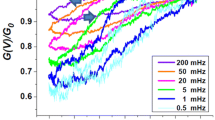Abstract
The gating current off-response of the frog node of Ranvier shows a fast and a slow phase, reflecting presumably charges moving back into the resting position and charges returning from immobilization. The paper describes measurements of the time constant of the slow component, υoff2, at different potentials at 20 or 17°C. The time constant υoff2 decreased markedly when the potential to which the fibre was repolarized at the end of the test pulses was decreased from −100 to −145 mV. υoff2 was compared with υoff2 gat and υoff2 Na, the time constants of the recovery of gating current and peak sodium current from the effect of a depolarizing conditioning pulse. The three time constants were equal at −145 mV, but somewhat different at −100 to −130 mV, the sequence being516-6. The inequality υoff2 gat < υoff2 was small and statistically not significant. It does not seem to be due to contamination of the charge movement with ionic currents because a) theQ off/Q on ratio was near 1.0 at −100 to −120 mV, b) partial replacement of internal CsCl by KCl did not significantly alter υoff2 orQ off/Q on, c) υoff2 was independent of pulse size. The small incquality υre gat < υoff2 suggests that charges which have returned from immobilization are not immediately available for displacement. The inequality υre gat < υre Na was larger and statistically significant at −100 and −110 mV. It confirms previous measurements of Nonner (1980). Although υre gat < υre Na, recovery of the gating current preceded recovery of the sodium current, because it started from a higher level.
Similar content being viewed by others
References
Armstrong CM (1981) Sodium channels and gating currents. Physiol Rev 61:644–683
Armstrong CM, Bezanilla F (1977) Inactivation of the sodium channel. II. Gating current experiments. J Gen Physiol 70:567–590
Attwell D, Dubois JM, Ojeda C (1980) Fully activated potassium current-voltage relationship in the Ranvier node. Pflügers Arch 384:49–56
Brismar T (1973) Effects of ionic concentration on permeability properties of nodal membrane in myelinated nerve fibres ofXenopus laevis. Potential clamp experiments. Acta Physiol Scand 87:474–484
Campbell OT (1983) Socium channel gating currents in frog skeletal muscle. J Gen Physiol 82:679–701
Chiu SY (1977) Inactivation of sodium channels: Second order kinetics in myelinated nerve. J Physiol 273:573–596
Chiu SY (1980) Asymmetry currents in the mammalian myelinated nerve. J Physiol 309:499–519
Chiu SY, Schwarz W (1987) Sodium and potassium currents in acutely demyelinated internodes of rabbit sciatic nerves. J Physiol 391:631–649
Dubois JM, Bergman C (1975) Potassium accumulation in the perinodal space of frog myelinated axons. Pflügers Arch 358:111–124
Frankenhaueser B, Moore LE (1963) The effect of temperature on the sodium and potassium permeability changes in myelinated nerve fibres ofXenopus laevis. J Physiol 169:431–437
Grissmer S (1986) Properties of potassium and sodium channels in frog internode. J Physiol 381:119–134
Heggeness ST, Starkus JG (1986) Saxitoxin and tetrodotoxin. Electrostatic effects on sodium channel gating current in crayfish axons, Biophys J 49:629–643
Hille B (1968) Charges and potentials at the nerve surface: Divalent ions and pH. J Gen Physiol 51:221–236
Hille B (1979) Rate theory models for ion flow in ionic channels of nerve and muscle. In: Stevens CF, Tsien RW (eds) Membrane transport processes, vol 3. Raven Press, New York, pp 5–16
Hille B, Woodhull AM, Shapiro BI (1975) Negative surface charge near sodium channels of nerve: divalent ions, monovalent ions, and pH. Phil Trans R Soc Lond B 270:301–318
Hof D (1986) A palse generating and data recording sysytem based on the microcomputer PDP 11/23. Comput Method Program Biomed 23:309–315
Keynes RD (1986) Modelling the sodium channel. In: Ritchie JM, Keynes RD, Bolis L (eds) Ion channels in neural membranes. Liss, New York, pp 85–101
Keynes RD, Malachowski GC, van Helden DF (1979) The effect of calcium on the sodium gating current in the squid giant axon. J Physiol 295:54P-55P
Keynes RD, Malachowski GL, van Helden DF, Greef NG (1980) Components of the asymmetry current in the squid giant axon. In: Salanki J (ed) Physiology of excitable membranes. Pergamon Press, Oxford New York, pp 37–49
Meves H, Rubly N, Watt DD (1987) Gating current experiments on frog nodes of Ranvier treated withCentruroides sculpturatus toxins or aconitine. Pflügers Arch 409:381–393
Nonner W (1969) A new voltage clamp method for Ranvier nodes. Pflügers Arch 309:176–192
Nonner W (1979) Effects ofLeiurus scorpion venom on the “gating” current in myelinated nerve. Adv Cytopharmacol 3:345–352
Nonner W (1980) Relations between the inactivation of sodium channels and the immobilization of gating charge in frog myelinated nerve. J Physiol 299:573–603
Nonner W, Rojas E, Stämpfli R (1978) Asymmetrical displacement currents in the membrane of frog myelinated nerve: Early time course and effects of membrane potential. Pflügers Arch 354:1–18
Ochs G, Bromm B, Schwarz JR (1981) A three-state model for inactivation of sodium permeability. Biochim Biophys Acta 645:243–252
Plant TD (1986) The effects of rubidium ions on components of the potassium conductance in the frog node of Ranvier. J Physiol 375:81–105
Pohl J-A (1988) Gating current experiments on the frog node of Ranvier Recovery from charge immobilization. Pflügers Arch 412 (Suppl 1):125
Rack M, Richter D, Rubly N (1987) Purification and characterization of a β-toxin from the venom of the African scorpionLeiurus quinquestriatus. FEBS Lett 214:163–166
Sachs L (1984) Angewandte Statistik. 6th ed. Springer, Berlin Heidelberg New York
Schauf CL (1974) Sodium currents inMyxicola axons: non-exponential recovery from the inactive state. Biophys J 14:151–154
Stämpfli R (1969) Dissection of single nerve fibres and measurements of membrane potential change of Ranvier nodes by means of double air gap method. In: Passow H, Stämpfli R, (eds) Laboratory techniques in membrane biophysics. Springer, Berlin Heidelberg New York, pp 157–166
Author information
Authors and Affiliations
Rights and permissions
About this article
Cite this article
Pohl, JA. Recovery from charge immobilization in sodium channels of the frog node of Ranvier. Pflugers Arch. 414, 516–522 (1989). https://doi.org/10.1007/BF00580986
Received:
Revised:
Accepted:
Issue Date:
DOI: https://doi.org/10.1007/BF00580986




